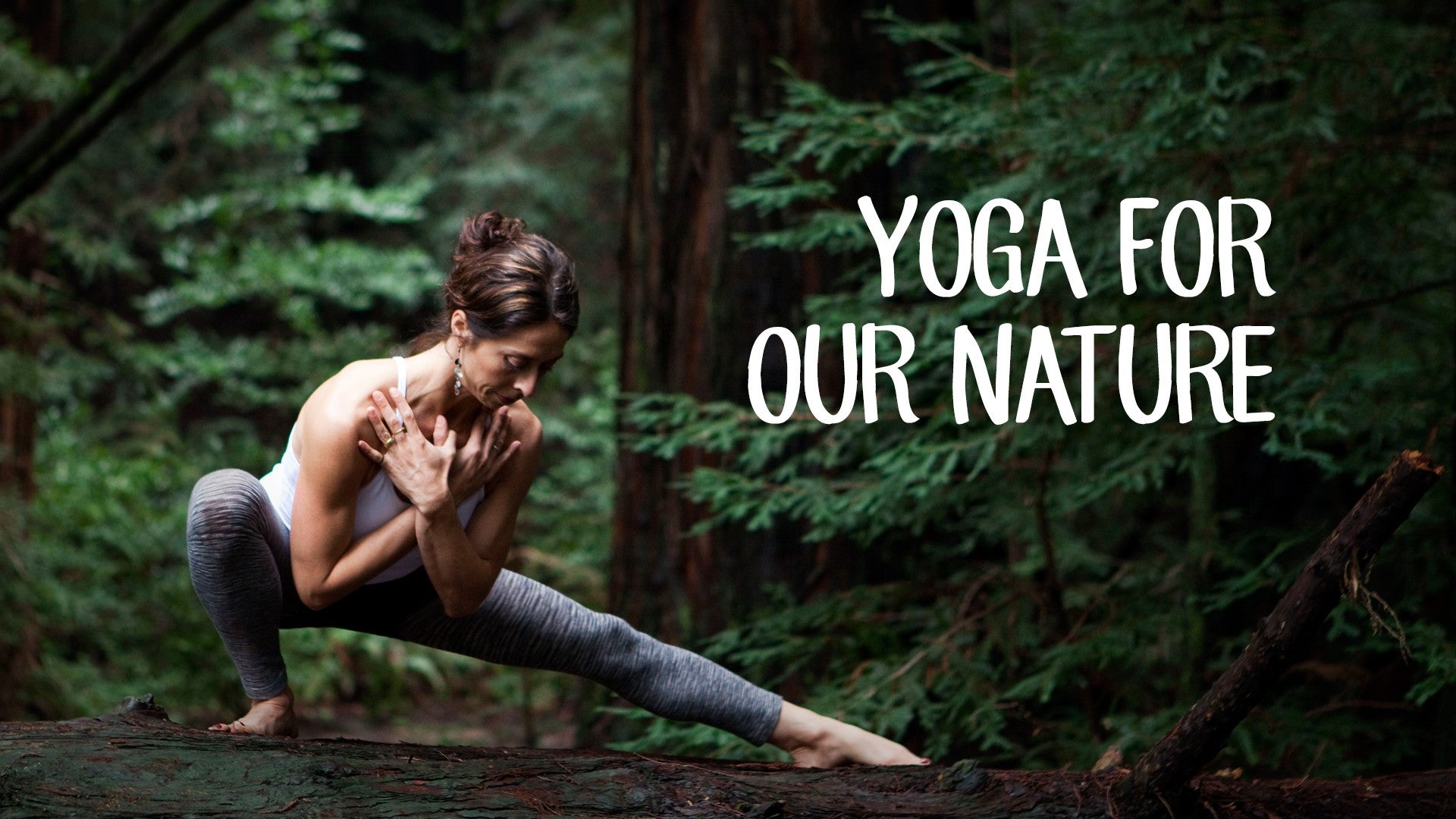Description
About This Video
Transcript
Read Full Transcript
(ocean waves) Hello, and welcome to the rest and digest vata reducing practice. This practice would be a wonderful treat to do at the end of a really busy day or just maybe in the middle of a very busy day to take a few minutes for yourself to calm down. Also, a great practice to do literally after you had lunch or had a meal. A wonderful way just to calm down and let your energy and blood go toward your stomach area where you might be actually digesting. A nice way to just take a little break and slow down.
For this practice, you'll need two blocks and a bolster. We're gonna start on our back. We'll do many of the poses on our back. I'd like you to use the bolster under your spine and to have the blocks available to use underneath the sides of your legs. So, when you recline back, let the bolster catch the back of your ribcage.
We're gonna use the blocks, maybe flat height or medium height, to catch your legs, so there's a little bit less effort in holding the legs up. If you felt a little bit full or if there was any discomfort in your stomach region, you might put a blanket under your head, so you can have a little bit more height, so the head is higher than the stomach or the heart and if you're comfortable now as you are, relax your arms out to your sides, feel the support underneath your spine, underneath your legs, underneath your feet. Can we go through that conscious scanning of the body, starting at the top of the head, working down toward the feet to soften and relax muscles along the way, starting across the forehead. Letting go of any tension that we typically hold in the forehead. Scanning through the eye socket.
Trying to feel the eyes settle more back into the head. Allowing the expression to soften entirely in the face. Relax the cheeks, relax the lips, relax the lower palate from the upper palate, relax the muscles of the throat, relax any tightness across the front of the chest. Simply allow for gravity to take the arms a little bit more back toward the bolster, a little more back toward the earth. Feel the places where the elbows touch the ground, the wrist or the knuckles touch the ground.
Try to rest the muscles now along the inner arms and then into your palms. Bring your awareness back to your torso and try to relax the back of the ribs into the bolster support. Feeling your belly as open as it can be here. Relaxing on the inhalations, feeling spacious, and as you exhale, allowing the belly just to gradually slowly fall toward the back muscles, toward the earth, without creating any tightness or gripping. Feeling, again, that sense of ease and spaciousness.
Move further down into the lower half of the belly. Feeling into the natural curve of your lumbar spine. Feeling into how the back of the pelvis is meeting the ground. Feel those contact points, again, where the blocks are holding your legs. And we let go of any gripping of the inner leg line.
Relaxing muscles of the calves, all the way down to your ankles, all the way down into your feet. Try to keep the body this soft. Just relax as you tend a little bit more to the breath and awareness of breath coming in and out of the nose and eventually, maybe a little bit more awareness of holding the breath out at the end of the exhale, so there's a moment where the body feels empty and, hopefully, also very full. You're breathing in. Become aware, as you breathe out, you pause, maybe when the lungs are three quarters empty, to pause in that transition space, resting in that emptiness before filling back up on the in breath.
Please try a few more rounds where you pause at the end of your exhale. Hold the breath out and just feel the senses go a little bit more inside before you take in that next nourishing breath. Two more just like that. At the end of the exhale, there's a little pause, senses going a little bit deeper inside. May we continue to remember that way of breathing throughout the rest of the practice and let the knees, when you're ready, slowly move toward each other.
Set the blocks out of your way for a moment and we'll continue using the bolster, now, and if we roll over to your right side, come off of the bolster slowly. Slide the bolster, maybe out to the right side of the mat, and we're gonna actually work into a twist, where if we start on your back, take your right leg straight, and we'll have the left leg rest completely on the bolster. So, you turn onto your side. As you spread your arms out to the side, if you find this left side of the chest is uncomfortable, just take your left arm a little bit more down toward the side of your body. If you'd like to feel a little bit more stretch through the chest, you can take your arm out a little bit more to your shoulder height.
Right hand can either stay on this left knee, hold the knee toward the bolster. Do whatever feels comfortable. When you've made all the little adjustments that you need to to be happy here, let your eyes close if you're comfortable. Take a moment to feel the support under your leg, feel what's opening through the chest, the sensations, maybe, in your belly, and letting your attention travel through the body, just noticing where sensations arise, noticing the impermanent nature of the sensations, staying open and curious about where the sensations may go, and using your breath as your guide and your teacher to determine if it's appropriate to stay in the pose or if it's a little bit overwhelming, how to slightly move into a more simple shape. So, maybe you need a little less sensation.
So, be creative with your adjustments, the micro adjustments, so we can stay put for maybe another 30 seconds in the same shape, allowing the props to support you. So, in this case, you might feel a little bit more connected to your breath opening in the left chest, mild rotation around the ribcage. Maybe over the next breath or two, let that left arm come all the way down to your side. Please roll onto your back. Have your feet on the ground for a moment in neutral.
Just feel the difference from your left to right side and if we stretch that left leg out to the floor, transfer your bolster over to your left side, and then we're gonna roll over onto that left side of the body with your right knee and right shin, your right foot all the way on the prop and then take that right arm out to your side or more down to the side of your body. The left hand might support that right knee, staying on the bolster. There's no right or wrong way, but try to get as much support as you can from the floor and from that prop under your knee. When you're done exploring possibilities in the shape, relax your gaze, take your focus inward. See if you can locate the breath, in that little space that exists at the end of your exhale.
Noticing how much effort it takes to stay connected to your breath. Simple as it might be, it's not always so easy to follow the breath. Eventually noticing maybe it's a little bit easier to settle into that space after you've exhaled. No breath for a moment and hopefully feeling just a little bit more calm, a little bit more stable in that pause. Stay for maybe about another 30 seconds and stay with your breath, knowing other thoughts might come to mind.
Just know where your mind went and come back to the breath. Any point now, maybe the next breath or two, just slide that right arm down by your side, set your feet on the ground, and when your feet are on the ground, roll onto the back. We don't need the prop anymore. Set your bolster to the side. Take your right knee toward your chest and open your knee out to the side, so it's not pressing onto your belly.
We're gonna take the right foot up toward the ceiling and hopefully catch the pinky edge of that right foot. If that's difficult, actually, to reach your foot, you could always use a strap around the bottom of the foot. So, this is like a half happy baby pose, but keep that right heel above the right knee. Maybe even hold the arm to the outside of the leg and gently guide that right knee a little bit more down toward the floor beside your chest. So, we could almost work this pose with the left leg bent.
You're also welcome to stretch the left leg down to the floor if you'd like a little bit more intense stretch. I'm gonna show the model of a little bit less intense stretch. Just nice and easy and maybe another 30 seconds with that right leg out in our half happy baby pose. Really tending to the stretch through that inner right leg, groin, toward the back of that right knee. An easy breath down to the lower abdomen.
Another breath or two. We'll go ahead and release the heel down, set the right foot down and then bring that left knee in toward the belly and then to the side of the belly, so there's no pressure if you're still, perhaps, actually digesting. The left foot comes up. Try to catch the pinky edge of your foot. You can rest your right arm at your side or your arm might slide to the outside of the leg and you're guiding that whole knee, thigh, down toward the side of your belly and the side of your chest.
And then, coming back to the practice of breathing. What's it like to try to establish that rhythm? That includes the pause at the end of exhale. Just more of a cooling practice. Then, something you might do if you feel really stressed out or maybe if you're struggling with insomnia, we try to focus on these pauses after the exhale.
A way to calm down the mind. Please take just a few more breaths on your back in that half happy baby pose with your left inner leg open. This feels like we've held it close to the same time as the first side. Drop that left foot all the way down toward the floor, roll over to your right side, and then we'll come all the way up away from the ground and as we come up, now, away from the ground, cross your ankles and we wanna grab one of your blocks. If the knees are riding up higher than the hips, you might even sit on your bolster, so that your knees would come down lower than your hips.
This would be a place holder. We may or may not want it. I'll turn it tall, so you have the highest option. What I'll do is lean over to the side and rest my right elbow on my block and potentially take my head over to this fist. We can continue to stay here for the rest of this pose.
If you'd like a little more sensation, you might turn the block a little bit flatter and come down to your side where your head's hanging to the side or you're resting your head on that fist and just use your left hand here to give a little bit of downward pressure toward that left knee and starting to feel this length through the left side of your body here, a little bit of squeezing of the organs on the right side. The waist is shortened in this pose. And just take a few more breaths. Close your eyes if you feel comfortable using this more like a meditation seat to explore your breath and that little pause at the end of your exhale. Taking just a few more seconds just to feel what you're feeling down that left side of your waist and into maybe even your lower back.
Over the inhale, let your head come up and then as we come up to neutral, transfer that block, maybe the tall side in case this side's a little bit stiffer. When you lean over to your left side you might make that fist and prop your head here. Right hand is pressing that right knee down toward the floor or come into the pose with the lower block to the side and then as we shorten this left waist, we're opening this right side of the body and then press that right hand down to the right knee and just gentle easing to the side and maybe close your eyes, so the pose feels a little more like a meditation pose. Reduce some of that external stimulation. Listen for the breath.
Feel for the end of your exhale and that little pause. Take a moment to drop a little deeper into our self. It's a quiet space. And appreciating the ease of the pose, the support in the posture. Now, over the next breath or so, let the head start to come up.
You can press against the block and come back up to neutral. So, now I'm gonna have you stretch your legs out to the side and with your legs out to the side we're gonna take that tall block as a prop and we might shift the shape of the prop a few times, but for starters, with the legs straight, so there's no pressure in the belly as you're coming forward. You might prop your elbows onto the block and catch your head with your hands and just one pose to bring some downward moving energy towards the lower abdomen, toward the inner legs and thighs, which are areas that thought to rules and if you feel like there's not enough sensation there, we know we're just gonna keep turning that block flatter or maybe even get the block out of the way. So, you come forward in a way that's interesting for you. Maybe catch your head again.
Another option, if you wanna be more in touch with the ground is to turn the block tall, rest your forehead here and then also consider putting your hands on the ground. So, whichever pose, again, bring some feeling into the legs and hips, allows you to let go through the neck, through the shoulders, and perhaps you're meditating on the transient sensations through the hips, through the legs. Perhaps you're finding a little more comfort, a little bit more ease and delight in those moments where we finish exhaling and there's no breath in the body. Eyes closed. Again, reducing that external stimulation for another few minutes and taking this time out or rest and digest space in your afternoon or evening.
And then, over the next, maybe two breaths, staying with the pose and the sensations. Over the next breath or two, when you're ready, walk your hands back in toward the inner legs. The spine comes up and we can set this block to the side. Pull your legs in into a cross legged position. I'll encourage you to sit on your cushion, so you've got actually a little bit of height.
We can stay lifted just so there's a little more ease in the pose. Let the hands rest for a moment down on your knees. Sit up nice and tall. If you've become familiar with the hand position for alternate nostril breathing, go ahead right away. Start curling your index finger, middle finger to your palm.
If not, this is what it looks like again. Take your thumb and your ring finger towards your nostrils and feel for the space above the fleshy part of the nostril. At this point, you might close your eyes and try to feel what it's like when you block the right nostril and use your ring finger to slightly close the opening of the left nostril, so it's not wide open when you breath in. It's slightly narrowed. And now, please, breathe in through your left nostril.
A little bit of valving. Now, block the left nostril and block your right nostril a little bit, so it's slower to breathe out through the right side. Keep the channel of the right nostril narrow as you breathe in. Close your right nostril entirely, narrow the left side, and exhale out the left nostril. Keep the opening narrow.
Inhale through the left nostril. So, you're breathing in more slowly than maybe the normal. Block the left nostril, exhale out the right, but narrow the opening. Inhale through your right side. Narrow the opening.
Block the right, exhale left. Narrow the opening by applying gentle pressure just above the nostril. Try to find a comfortable rhythm. Keep doing that practice, alternating the inhale and exhale. Balancing from maybe an active, intelligent, stimulating day and trying to shift maybe into more creative space.
As we come through the balance between the right and left hemispheres of the brain, at some point you'll start to feel like the breath is evenly moving up through both nostrils. And just simply using this awareness is something to be curious, to learn a little bit more about yourself, to give us an object of concentration, so the mind stays present on the task at hand. Let's do one more full cycle of breathing in through the left side and ending with an exhale on the left side. When you're complete, let your hands rest down on your knees for a moment on the tops of your thighs and take a few deep breaths in and out through the nose. Just noticing the fact of a simple, restorative like practice, to help you feel maybe a little bit more calm or maybe help you digest after a meal.
And any time you're ready, perhaps letting the eyes open if they've closed, gathering the hands in front of the heart and just a moment of gratitude for the practices of yoga and all the teachers passing down these wonderful gifts to help us feel a little more balanced and stable. Namaste. Thank you.
Yoga for Our Nature: Dosha Jam
Comments
You need to be a subscriber to post a comment.
Please Log In or Create an Account to start your free trial.

























